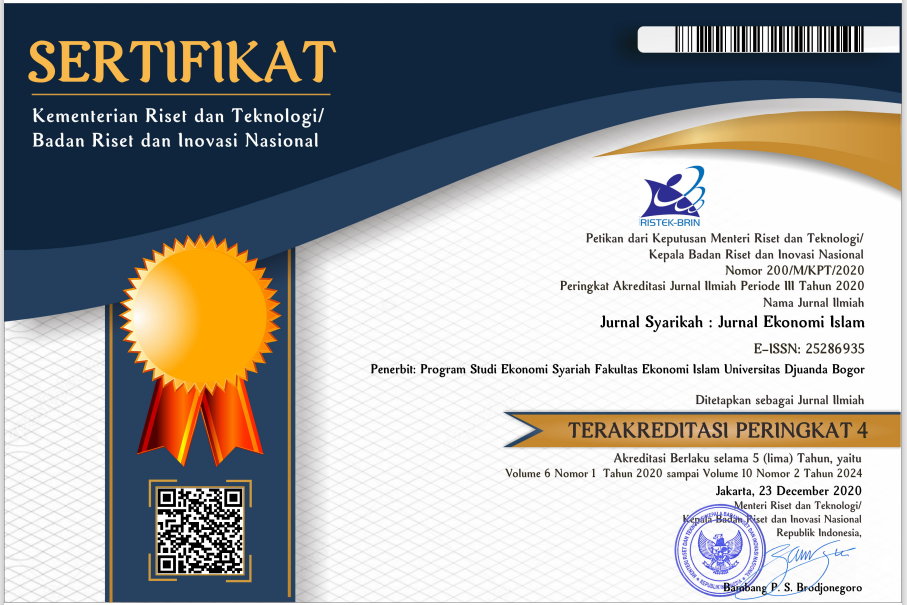DEBT IN THE PERSPECTIVE OF ISLAMIC LAW
DOI:
https://doi.org/10.30997/jsei.v6i1.2187Keywords:
Debt, Islamic Law, Ujrah, Usury, SodaqohAbstract
The goal of this paper is to analyze the debt from view of Islamic law. Debt is one of the muamalah instruments in Islam that used for activities in household, companies, and countries to fulfill their life sustainability. At least in two things. First in the fulfillment of the fifth pillar of Islamic obligations, pilgrimage, but there is a polemic using debts because of the additional administrative costs (ujrah). The other side of the polemic of debt in the economic system of Islam even could prevent the world economic crisis, the global economic crisis due to debt plus interest in exchange in the capitalist economic system, but not use Islamic economic system in the world. The method used is a normative method and the analysis shows debt could be for bailout funds for pilgrimmage program as long as the debtor pay this loan as soon as possible, debt is the last option and the value of debt should be measured in accordance with the ability to avoid further misery and debt can provide economic value as long as it is used for business or trade to achieve the world welfare, and the hereafter without performing maisir, farad, usury and tyranny. Sodaqoh and giving sincerely is better than giving debt.References
[2] Ammi Nur Baits, “Hukum Haji dengan Hutang” retrieved 25 Juli 2019 from https://konsultasisyariah.com/22163-hukum-haji-dengan-hutang.html
[3] Heri Sudarsono, “Dampak Krisis Keuangan Global terhadap Perbankan di Indonesia: Perbandingan antara Bank Konvensional dan Bank Syariah”, La Riba Jurnal Ekonomi Islam Volume III, No. 1, Juli 2009 p.12-23
[4] Nour Sad Alden, " Comparative Analysis Between Islamic and Conventional Banking Systems In Terms of Profitability and Governance " (Thesis at Eastern Mediterranean University, Cyprus, September 2015, p.2), retrieved July 25, 2019, from https: / /pdfs.semanticscholar.org/061c/ee28434ba3b39aea83db4344dcd3f5393dde.pdf
[5] Facts and Details, " 1997-98 Asian Financial Crisis In Indonesia" retrieved 20 Juli 2019 from http://factsanddetails.com/indonesia/History_and_Religion/sub6_1c/entry-3962.html
[6] Heri Sudarsono, “Dampak Krisis Keuangan Global terhadap Perbankan di Indonesia: Perbandingan antara Bank Konvensional dan Bank Syariah”, La Riba Jurnal Ekonomi Islam Volume III, No. 1, Juli 2009 p.12-23
[7] Muhamad Amin Suma, Tafsir Ayat-Ayat Ekonomi, (Jakarta: AMZAH, 2013)
[8] Tedy Rizkha Heryansyah, “ Ekonomi Kelas 10 | Pilih Menabung di Bank Konvensional atau Bank Syariah?” retrieved 20 Juli 2019 from
https://blog.ruangguru.com/ekonomi-kelas-10-pilih-menabung-di-bank-konvensional-atau-bank-syariah
[9] Heri Sudarsono, “Dampak Krisis Keuangan Global terhadap Perbankan di Indonesia: Perbandingan antara Bank Konvensional dan Bank Syariah”, La Riba Jurnal Ekonomi Islam Volume III, No. 1, Juli 2009 p.12-23
[10] Enriche Putera Hutama, Materi ToT Dosen, Pokja Literasi dan Inklusi Keuangan, Buku 8 Otoritas Jasa Keuangan : Industri Jasa Keuangan Syariah, Seri Literasi Keuangan Perguruan Tinggi, retrieved 3 Juni 2019 from Power Point materi presentasi
[11] Nour Sad Alden, " Comparative Analysis Between Islamic and Conventional Banking Systems In Terms of Profitability and Governance " (Thesis at Eastern Mediterranean University, Cyprus, September 2015, p.2), retrieved July 25, 2019, from https: / /pdfs.semanticscholar.org/061c/ee28434ba3b39aea83db4344dcd3f5393dde.pdf
[12] Mohammad Bitar, Philippe Madies, and Olivier Taramasco. "What Makes Islamic Banks Different? A Multivariate Approach." Economic Systems 41, no. 2 (2017): 215-235.
[13] Saber Mollah, and Mahout Haman. Shari'ah Supervision, Corporate Governance and Performance: Conventional Vs. Islamic Banks. Journal of Banking & Finance 58 (2015): 418-435.
[14] M. Kabir Hassana and Ashraf Khan, " W hat Is Islamic Finance And What Can It Do?" retrieved 16 June 2019 from http://e-resources.perpusnas.go.id:2308 / eds / previewer / previewer? vid = 1 & sid = eb1d8105-98f4-4bf9-8709-f279f40afc42% 40sdc-v-sessmgr06
[15] Alfred Kammer, Mohamed Norat, Marco Piñón, Ananthakrishnan Prasad, Christopher Towe, Zeine Zeidane, and an IMF Staff Team, 2015. Islamic Finance: Opportunities, Challenges, and Policy Options, Washington, DC USA.: INTERNATIONAL MONETARY FUND at INTERNATIONAL MONETARY FUND retrieved April 12, 2019, from https://www.imf.org/external/pubs/ft/sdn/2015/sdn1505.pdf
[16] Heri Sudarsono, “Dampak Krisis Keuangan Global terhadap Perbankan di Indonesia: Perbandingan antara Bank Konvensional dan Bank Syariah”, La Riba Jurnal Ekonomi Islam Volume III, No. 1, Juli 2009 p.12-23
[17] Martin Manurung, “Krisis Finansial Global: Dari Wall Street ke All Streets dan Respons Indonesia”, Jurnal Sosial Demokrasi Vol. No. 1 Januari - Maret 2009 h.37-43
[18] Moh Agus Nugroho, “Esensi Hutang Dalam Keuangan Rumah Tangga Yang Islami”, Bilancia, Vol. 11 No. 2, Juli-Des 2017 h.391-410
[19] Mohammad Bitar, Philippe Madies, and Olivier Taramasco. "What Makes Islamic ... " p. 215-235.
[20] Saber Mollah, and Mahout Haman. " Shari'ah Supervision ... " p 418-435.
[21] M. Kabir Hassan and Ashraf Khan, "What Is Islamic Finance ..." from http: //e-resources.perpusnas.go.id#308/eds/previewer/previewer?vid=1 & sid=eb1d8105-98f4 -4bf9-8709-f279f40afc42% 40sdc-v-sessmgr06
[22] Alfred Kammer, Mohamed Norat, Marco Piñón, Ananthakrishnan Prasad, Christopher Towe, Zeine Zeidane, and an IMF Staff Team, 2015. "Islamic Finance: Opportunities, ..." https://www.imf.org/external /pubs/ft/sdn/2015/sdn1505.pdf
[23] Muh. Jarful, The Principles for Islamic Debt Contracts in the Sharia Pawnshop of Indonesia, Journal of Law, Policy and Globalization Vol.61, 2017 p.122-125.
[24] Peter Mahmud Marduk, The Legal Research, (Jakarta: Kencana Grenada Media Group, 2005) , p.93.
[25] Mark Van Hoecake, Methodologies of Legal Research, Which Kind of Method for What Kind of Discipline e? European Academy of Legal Theory Vol. 9, 201 1 p. 2 – 294
[26] Faisar Ananda Arfa, Filsafat Hukum Islam, (Medan:Citapustaka Media Perintis, 2007) h.5-6
[27] Enriche Putera Hutama, Materi ToT Dosen, Pokja Literasi dan Inklusi ...” Power Point materi presentasi
[28] Referensi Makalah, “Pengertian Maqasid Al Syariah” retrieved 25 juli 2019 from https://www.referensimakalah.com/2011/09/pembicaraan-tentang-maqasid-al-syari_1553.html
[29] Qamar Uz Haman, M. Kabir Heisman, Waheed Akhter, Jennifer Brodmann, "Does the tax shield align with the Al-Shariah maqasid in finance?", Bursa Istanbul Review 19-1 (2019) p.39-48
[30] Eva Muzlifah, “Maqashid Syariah Sebagai Paradigma Dasar Ekonomi Islam”, Economic: Jurnal Ekonomi dan Hukum Islam, Vol. 3, No. 2, tahun 2013, h.73-94
[31] Qamar Uz Haman, M. Kabir Heisman, Waheed Akhter, Jennifer Brodmann, "Does the interest tax ...?", P.39-48
[32] Zairani Zainol, Aini Nur Haj jar Khairol Nizam, Rosemarie Ab Rash id, Exploring the Concept of Debt from the Perspective of the Objectives of the Shariah, International Journal of Economics and Financial Issues | Vol 6 • Special Issue (S7) • 2016 p.304 -312
[33] Abdul Aziz dan Ramdansyah, “Esensi Utang Dalam Konsep Ekonomi Islam”, BISNIS, Vol. 4, No. 1, Juni 2016, h.124-135
[34] Moh Agus Nugroho, “Esensi Hutang Dalam Keuangan ..”, h.391-410
[35] Muhamad Amin Suma, Tafsir Ayat-Ayat Ekonomi, (Jakarta: AMZAH, 2013)
[36] Abdul Aziz dan Ramdansyah, “Esensi Utang Dalam ...”, h.124-135
[37] FinancialIslam.com, " Loans and Debts in the Shariah", retrieved 21 July 2019 from http://www.financialislam.com/loans-and-debts-in-the-shariah.html
[38] Abdul Aziz dan Ramdansyah, “Esensi Utang Dalam ...”, h.124-135
[39] Enriche Putera Hutama, Materi ToT Dosen, Pokja Literasi dan Inklusi ...” Power Point materi presentasi
[40] Muhamad Amin Suma, Tafsir Ayat-Ayat Ekonomi, (Jakarta: AMZAH, 2013) h.5-7
[41]Made by writer from various sources
[42] Abdul Aziz dan Ramdansyah, “Esensi Utang Dalam Konsep ...”, h.124-135
[43] Ady Cahyadi, MENGELOLA HUTANG DALAM PERSPEKTIF ISLAM, ES ENSI Jurnal Bisnis dan Manajemen Vol. 4, No. 1, April 2014 h.67-78
[44] Abdul Aziz dan Ramdansyah, “Esensi Utang Dalam Konsep...”, h.124-135
[45] Syahnaz binti Sulaiman (Jakim). “Konsep Pinjaman Menurut ...”, http://www.myjurnal.my/filebank/published_article/34094/Article_8.PDF
[46] Al-Zuhayli, Fiqh al-Islami wa Adillatuhu, Juz 5, m.s 3787.
[47] Abdul Aziz dan Ramdansyah, “Esensi Utang Dalam Konsep ...”, h.124-135
[48] DSN MUI Number 19 of 2000
[49] Syahnaz binti Sulaiman (Jakim). “Konsep Pinjaman Menurut ...”, http://www.myjurnal.my/filebank/published_article/34094/Article_8.PDF
[50] Moh Agus Nugroho, “Esensi Hutang Dalam Keuangan ..”, h.391-410
[51] Syahnaz binti Sulaiman (Jakim). “Konsep Pinjaman Menurut ...”, http://www.myjurnal.my/filebank/published_article/34094/Article_8.PDF
[52] Syahnaz binti Sulaiman (Jakim). “Konsep Pinjaman Menurut ...”, http://www.myjurnal.my/filebank/published_article/34094/Article_8.PDF
[53] Abdul Aziz dan Ramdansyah, “Esensi Utang Dalam Konsep ...”, h.124-135
[54] Nour Sad Alden, "Comparative Analysis Between Islamic ... " https://pdfs.semanticscholar.org/061c/ee28434ba3b39aea83db4344dcd3f5393dde.pf
[55] Sandstad (2009) in Nour Sad Alden, " Comparative Analysis Between Islamic and Conventional Banking Systems In Terms of Profitability and Governance " (Thesis at Eastern Mediterranean University, Cyprus, September 2015, p.2), retrieved July 25, 2019, from https://pdfs.semanticscholar.org/061c/ee28434ba3b39aea83db4344dcd3f5393dde.pdf
Downloads
Published
How to Cite
Issue
Section
License
Authors who publish with Jurnal Syarikah: Jurnal Ekonomi Islam agree to the following terms:
- Authors retain copyright and grant the journal right of first publication with the work simultaneously licensed under a Creative Commons Attribution 4.0 International License that allows others to share the work with an acknowledgement of the work's authorship and initial publication in Jurnal Syarikah: Jurnal Ekonomi Islam.
- Authors are able to enter into separate, additional contractual arrangements for the non-exclusive distribution of the journal's published version of the work (e.g., post it to an institutional repository or publish it in a book), with an acknowledgement of its initial publication in Jurnal Syarikah: Jurnal Ekonomi Islam.
- Authors are permitted and encouraged to post their work online (e.g., in institutional repositories or on their website) prior to and during the submission process, as it can lead to productive exchanges, as well as earlier and greater citation of published work
SURAT PERNYATAAN PEMINDAHAN HAK CIPTA[1]
Yang bertanda tangan di bawah ini adalah penulis naskah yang berjudul:
yang diajukan untuk dipublikasikan pada Jurnal Syarikah : Jurnal Ekonomi Islam ISSN 2442-4420 menyatakan bahwa:
Kami bersedia memindahkan hak publikasi, distribusi, reproduksi, dan menjual naskah kamiyang berjudul tersebut di atas sebagai bagian dari Jurnal Syarikah kepada Dewan Redaksi Jurnal Syarikah : Jurnal Ekonomi Islam ISSN 2442-4420
Demikian surat pernyataan ini saya buat dengan sadar, penuh rasa tanggung jawab, dan tanpa paksaan dari pihak mana pun!
No | Nama Penulis (lengkap dengan gelar akademik) | Nama dan Alamat Institusi, email | Tanda Tangan | Tanggal |
1 |
|
|
|
|
2 |
|
|
|
|
3 |
|
|
|
|
4 |
|
|
|
|
5 |
|
|
|
|
[1] Dikirim ke Dewan Redaksi Jurnal Syarikah, Program Studi Ekonomi Islam Fakultas Ekonomi Islam Universitas Djuanda Bogor, Gedung B Lantai IV Jl Tol Ciawi No. 1 Kotak Pos 35 Ciawi Bogor 16720, difaksimilikan ke 02518240985, dan hasil scanning-nya diemailkan ke Jurnal.Syarikah@unida.ac.id


